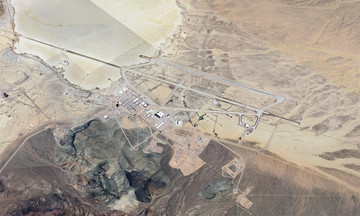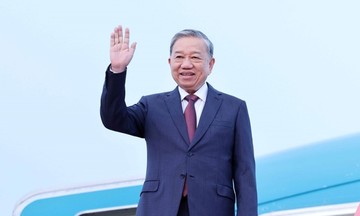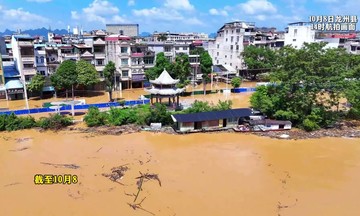The Pinglu Canal, a key project of the new land-sea corridor in Guangxi province, China, is a symbolic 21st-century endeavor in China's pursuit of becoming a global transportation powerhouse.
The Pinglu Canal is China's largest artificial canal project since the Grand Canal, built over 2,500 years ago. Construction began on 28/8/2022, with an estimated completion time of 54 months. As of 5/8, over 80% of the project is complete, and it is expected to be finished in 2026.
Originating at the mouth of the Pingtang River in the Xixin Reservoir area of Hengzhou county, Nanning, the canal traverses Luoc township in Lingshan county, Qinzhou, and ultimately flows into the Gulf of Tonkin via the Qin River.
The entire canal stretches 134.2 km and adheres to Class I inland waterway standards, accommodating vessels with a cargo capacity of up to 5,000 tons.
 |
Construction of the Madao lock in Qinzhou city, Guangxi province, on 6/8. Photo: Hong Hanh |
The project, with a total investment of approximately 72.7 billion CNY (over $10 billion USD), aims to enhance waterway transportation, provide water for irrigation, mitigate flooding, and improve the river's ecological environment.
According to the environmental impact assessment, the Pinglu Canal is projected to transport 108 million tons of goods by 2035, increasing to 130 million tons by 2050. The report indicates the canal will primarily carry coal, minerals, cement, grain, construction materials, and containers.
This canal will drastically shorten the travel time for container ships carrying goods from Nanning, the capital of Guangxi province, to Southeast Asian countries by eliminating the need to detour through the Pearl River Delta.
"Goods transported from southwestern regions to the sea via the Pinglu Canal will shorten the river journey by over 560 km compared to transport through Guangzhou port, saving 5.6 billion CNY in transportation costs annually," He Ni, a reporter for Guangxi Daily, told VnExpress.
 |
Location of the Pinglu Canal. Graphics: SCMP |
According to He Junhui, head of the Technical Management Department of the Pinglu Canal Group, the canal boasts the largest lock-based water-saving and transmission system within China's inland waterway network.
The project employs advanced in-situ concrete pouring technology, utilizes high-durability concrete and construction materials, and incorporates anti-seawater corrosion technology for the locks at the river mouth.
"The Pinglu Canal is not only a major project for Guangxi but also a crucial platform for large-scale scientific research projects," he said.
Hong Hanh












